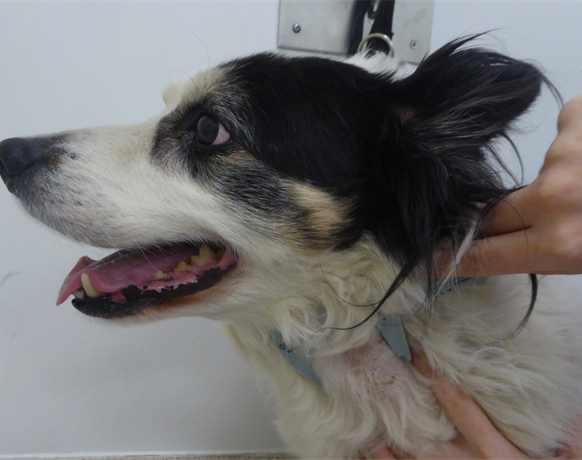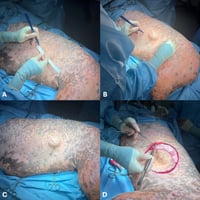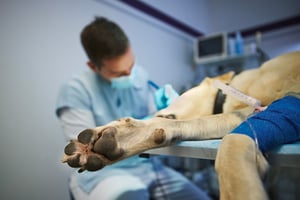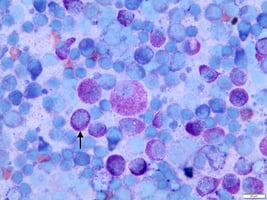Canine thyroid carcinoma is the most common endocrine malignancy in dogs (Barber, 2007). This neoplasm arises from the thyroid gland and represents 90 percent of the thyroid tumours in canine patients, typically affecting middle-aged to older dogs (Wucherer and Wilke, 2010). Thyroid carcinoma in dogs stems from the follicular cells, which are responsible for producing thyroid hormones (thyroxine (T4) and triiodothyronine (T3)), or the medullary cells, which produce calcitonin; however, follicular carcinomas are the most common (Athey et al., 2024).
Clinical presentation of canine thyroid carcinoma
The clinical presentation of canine thyroid carcinoma is variable, often depending on the size, location and metastatic spread of the tumour. One of the most frequent presentations is a palpable mass in the ventral cervical region, with no systemic signs of illness (Athey et al., 2024). Depending on the functional status of the tumour, dogs may exhibit signs of thyroid hormone imbalance. Most dogs with thyroid tumours are euthyroid, with 30 to 40 percent of dogs reported to be hypothyroid, although hypothyroid dogs with thyroid tumours are rarely symptomatic (Feldman et al., 2014). A smaller percentage of dogs present with hyperthyroidism, and this group of dogs often presents with the typical clinical signs, such as polyphagia, polyuria and polydipsia, weight loss, hyperactivity and cardiac arrhythmias or murmurs (Scott-Moncrieff, 2011).
Most dogs with thyroid tumours are euthyroid, with 30 to 40 percent of dogs reported to be hypothyroid, although hypothyroid dogs with thyroid tumours are rarely symptomatic
Staging and diagnosis
Staging is important in the management of canine thyroid carcinoma as it helps determine the extent of the disease spread, guides treatment decisions and can provide prognostic information. The staging process involves a combination of clinical evaluation and imaging studies. One of the most-used staging systems for canine thyroid carcinoma is the World Health Organization staging system which considers tumour size (T), lymph node involvement (N) and distant metastasis (M) (Table 1) (Owen, 1980).
| Stage | Primary tumour | Lymph nodes | Distant sites |
| I | T1a, b | N0 | M0 |
| II | T0 T1a, b T2a, b |
N1 N1 N0 or N1a |
M0 |
| III | T3 Any T |
Any N Any Nb |
M0 |
| IV | Any T | Any N | M1 |
| Legend: T0 – no evidence of tumour; T1 – tumour less than 2cm; T2 – tumour between 2 and 5cm; T3 – tumour more than 5cm; N0 – no evidence of regional lymph node involvement; N1 – ipsilateral regional lymph node involvement; N2 – bilateral regional lymph node involvement; M0 – no evidence of distant metastasis; M1 – distant metastasis present; a – not fixed; b – fixed | |||
A complete blood count and biochemistry profile provide a general health assessment and can identify any paraneoplastic syndromes or organ dysfunction that may influence treatment decisions. Blood tests to measure serum thyroid hormone levels (T4 and free T4) and thyroid-stimulating hormone (TSH) can help assess the functional status of the thyroid gland.
Metastasis can occur, particularly to the lungs and regional lymph nodes, but metastasis to abdominal organs has also been reported (Nadeau and Kitchell, 2011; London et al., 2012). Thoracic radiographs or computed tomography (CT) of the thorax should be performed to screen the patient for pulmonary metastatic disease, and abdominal ultrasound or abdominal CT can also be considered to investigate the presence of intra-abdominal metastasis.
When lymph node metastases are present, the most commonly affected lymph nodes are the retropharyngeal and deep cervical lymph nodes (Skinner et al., 2021, 2024). A CT of the head and neck can be useful to assess not only local lymph node size, but also the extent of the primary tumour and involvement of adjacent structures.
Lastly, nuclear imaging (thyroid scintigraphy), which involves the administration of a radioactive isotope, typically sodium pertechnetate, which is taken up by the thyroid tissue, can differentiate between hyperfunctional (hot) and non-functional (cold) thyroid nodules, and can identify ectopic thyroid tissue or metastatic sites (Daniel and Neelis, 2014).
An incisional biopsy of a thyroid mass is typically not recommended, as most thyroid masses are highly vascular (Lunn and Boston, 2019). Cytology can provide preliminary information about the cell line of the tumour, but it may not always yield a definitive diagnosis. Surgical excision is typically necessary for diagnostic and therapeutic purposes, and this may be pursued without previous sampling if the imaging findings are compatible with a thyroid gland mass.
Treatment and prognosis of canine thyroid carcinoma
Thyroidectomy
Surgery (thyroidectomy) is the treatment of choice for small and localised thyroid tumours, with median survival times of around three years reported with surgery alone for both functional and non-functional tumours (Frederick et al., 2020; Reagan et al., 2019; Scharf et al., 2020). Similarly, good outcomes have been reported in dogs with gross vascular invasion (Latifi et al., 2021) and bilateral thyroidectomies for bilateral tumours (Tuohy et al., 2012). Possible perioperative complications include haemorrhage, aspiration pneumonia and damage to the adjacent structures, such as the recurrent laryngeal nerve and parathyroid glands (Radlinsky, 2007; Reagan et al., 2019; Latifi et al., 2021).
Radiotherapy
Interestingly, metastatic disease does not seem to have prognostic significance in patients treated with radiotherapy
For tumours not amenable to surgical excision, radiotherapy can be considered as a primary local treatment option. Several different protocols have been described, including fractionated definitive-intent protocols, with good results: there was a 100 percent complete remission rate with a median survival time of two years in one study (Pack et al., 2001), and a progression-free survival rate of 72 percent at three years in another study (Théon et al., 2000). Palliative hypofractionated protocols seem to have more inconsistent responses, with median survival times of 170 days and 96 weeks reported (Brearley et al., 1999; Tsimbas et al., 2019). More recently, stereotactic body radiation therapy has been evaluated in the treatment of canine thyroid tumours, with a median survival time of one year (Lee et al., 2020). Interestingly, metastatic disease does not seem to have prognostic significance in patients treated with radiotherapy (Brearley et al., 1999; Lee et al., 2020). Side effects of radiotherapy may include erythema, mucositis, dysphagia, dysphonia, cough and alopecia (Pack et al., 2001; Tsimbas et al., 2019). Hypothyroidism post-radiotherapy develops in 47 percent of cases at a median time of six months after treatment, so monitoring of thyroid function after radiotherapy for thyroid tumours is advised (Amores-Fuster et al., 2017).
Chemotherapy
The role of chemotherapy in the treatment of canine thyroid carcinoma remains undefined. Despite one report suggesting there is no survival advantage for dogs treated with surgery and chemotherapy when compared with patients treated with surgery alone (Nadeau and Kitchell, 2011), it is often a part of a multimodal treatment approach for dogs with metastatic disease or with a high risk for developing metastatic disease (Liptak, 2007). It is important to remember that studies evaluating the use of chemotherapy are usually underpowered and retrospective, and as such it is likely that patients receiving chemotherapy were affected by more advanced or aggressive disease. Common chemotherapeutic agents include doxorubicin or carboplatin (Nadeau and Kitchell, 2011).
It is important to remember that studies evaluating the use of chemotherapy are usually underpowered and retrospective, and as such it is likely that patients receiving chemotherapy were affected by more advanced or aggressive disease
In a recent study evaluating the tyrosine kinase inhibitor toceranib in the treatment of naïve and previously treated thyroid tumours, clinical benefit was documented in the majority of dogs in both groups, with median survival times of 563 days and 1082 days, respectively (Sheppard-Olivares et al., 2020).
Radioactive iodine has also been reported as a treatment option for canine thyroid tumours, with an overall response rate of 35 percent and overall survival times reported of between 18 and 30 months (Worth et al., 2005; Jegatheeson et al., 2022).
Several prognostic factors have been identified as indicators of worse outcome, such as adjuvant chemotherapy and non-follicular subtype (Enache et al., 2023). Tumour diameter and volume, and bilateral tumour location have been associated with metastatic disease, and gross and histological evidence of vascular invasion were associated with a reduced disease-free survival (Campos et al., 2014). Interestingly, staging does not necessarily correlate with a worse prognosis (Giannasi et al., 2021).
_OL_CourseThumb.jpg?width=500&height=300&name=IVE_GPCert(Onco)_OL_CourseThumb.jpg)





